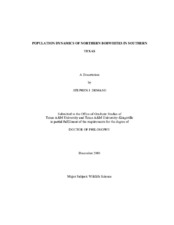| dc.description.abstract | Northern bobwhites (Colinus virginianus) are an important cultural, ecological, and economical part of the southern Texas landscape. I used radio-telemetry data from 2000?2005, part of a long-term, bobwhite study in southern Texas, to test the nest-concealment hypothesis, develop a stochastic simulation model for bobwhite populations, and evaluate the influence of brush canopy coverage (BCC) on short- and long-term demographic performance of bobwhites.
Bobwhite nests tend to be situated in taller and denser vegetation than would be expected if nest-site location was a random process. I compared 4 microhabitat variables between successful (n = 135) and depredated nests (n = 118). I documented similar microhabitat attributes between successful and depredated nests. The discriminant function correctly classified only 48?59% of nest fates into the correct group, but only 18% of the variation in nest fate. Thus, my results did not support the nest-concealment hypothesis.
My stochastic simulation model for bobwhite populations is based on difference equations (?t = 3 months) and simulations run for 100 years using STELLA� 9.0.2. The probability of persistence for 100 years for the spring population was 74.2% and 72.5% for the fall population. Simulated population parameters were similar to those observed in the field for 5 of 6 population parameters. Only simulated male adult annual survival differed by 275.0% from field estimates. Despite this difference, my model appears to be a good predictor of bobwhite populations in the Rio Grande Plains of Texas.
I estimated bobwhite density, survival, and production (proportion of hens nesting, nesting attempts per hen, and clutch size) in 3 study areas with ~10%, ~25%, and >30% BBC. All demographic parameters were similar among the 3 BCC classes. However, simulation modeling indicated that long-term demographic performance was greater on the ~25% and >30% BCC classes. The probability of fall population persistence was greater in the ~25% (90.8%) and >30% (100.0%) BCC classes than in the ~10% BCC class (54.2%). My study highlights the shortcoming of considering only short-term effects when comparing habitat given that short- and long-term effects of habitat on demographic performance can differ. | en |


